.png)
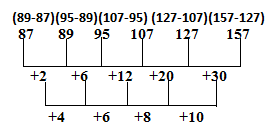
In the given question, select the related letter from the given alternatives.
DBCE:QOPR::JLKI:?
दिए गए प्रश्न में दिए गए विकल्पों में से संबंधित अक्षर को चुनिए।
DBCE:QOPR::JLKI:?
D(4)+13=17(Q)
B(2)+13=15(O)
C(3)+13=16(P)
E(5)+13=18(R)
Similarly in JLKI:?
J(10)+13=W(23)
L(12)+13=Y(25)
K(11)+13=X(24)
I(9)+13=V(22)
So the related letters are WYXV.
Hence the correct answer is option C.
D(4)+13=17(Q)
B(2)+13=15(O)
C(3)+13=16(P)
E(5)+13=18(R)
इसी तरह JLKI:? में
J(10)+13=W(23)
L(12)+13=Y(25)
K(11)+13=X(24)
I(9)+13=V(22)
संबंधित अक्षर WYXV हैं।
अतः सही उत्तर विकल्प C है।
How many triangles are there in the following figure?
निम्नलिखित आकृति में कितने त्रिभुज है ?
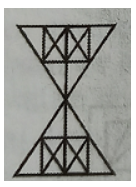
Triangle in LFHQ = 8
Triangle in FMQI = 8
Triangle in KPNG = 8
Triangle in PJGO = 8
Triangle in CHI = 3
Triangle in CKJ = 3
Triangle in ABC = 3
Triangle in CED = 3
△KEG + △KEN + △GJD + △JOD + △HFA + △ALH + △FBI + △BMI + △HFI + △LQM + △NPO + △KJG + △KCG + △CJG + △FIC + △FHC = 16
Total number of Triangle = 8 + 8 + 8 +8 + 3 + 3 + 3 + 3 + 16 = 60
So the correct answer is option B.
LFHQ में त्रिभुज = 8
FMQI में त्रिभुज = 8
KPNG में त्रिभुज = 8
PJGO में त्रिभुज = 8
CHI में त्रिभुज = 3
CKJ में त्रिभुज = 3
ABC में त्रिभुज = 3
CED में त्रिभुज = 3
△KEG + △KEN + △GJD + △JOD + △HFA + △ALH + △FBI + △BMI + △HFI + △LQM + △NPO + △KJG + △KCG + △CJG + △FIC + △FHC = 16
कुल त्रिभुजों की संख्या = 60
इसलिए सही उत्तर विकल्प B है l
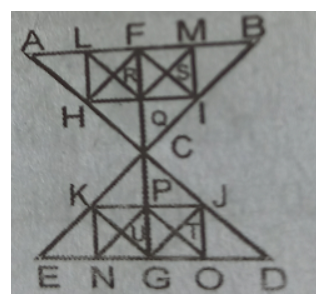
From the given figure option B figure is embedded in the question figure.
So the correct answer is option b.
You can see it clearly in the below image -
दी गई आकृति में से विकल्प B आकृति प्रश्न आकृति में सन्निहित है।
इसलिए सही उत्तर विकल्प B है।
इसे आप नीचे दी गई इमेज में साफ देख सकते हैं -
If PRIVATE is coded as 1234567 and RISK is coded as 2398, RIVERS will be coded?
यदि PRIVATE को 1234567 के रूप में कोडित किया जाता है और RISK को 2398 के रूप में कोडित किया जाता है, तो RIVERS को कोडित किया जाता है?
P=1
R=2
I=3
V=4
A=5
T=6
E=7
And
R=2
I=3
S=9
K=8
Code for RIVERS -
R=2
I=3
V=4
E=7
R=2
S=9
So the code for RIVERS is 234729.
Hence the correct answer is option C.
P=1
R=2
I=3
V=4
A=5
T=6
E=7
और
R=2
I=3
S=9
K=8
RIVERS के लिए कोड -
R=2
I=3
V=4
E=7
R=2
S=9
RIVERS का कोड 234729 है।
अतः सही उत्तर विकल्प C है।
JN is related to which of the following in the same way as AE is related to DH?
निम्नलिखित में किससे JN उसी प्रकार संबंधित है जिस प्रकार AE, DH से संबंधित है?
JN is related to MQ in the same way as AE is related to DH.
So the correct answer is option D.
You can see its solution in the picture below
MQ से JN उसी प्रकार संबंधित है जिस प्रकार AE, DH से संबंधित है।
इसलिए सही उत्तर विकल्प D है।
इसका समाधान आप नीचे दिए गए चित्र में देख सकते है।
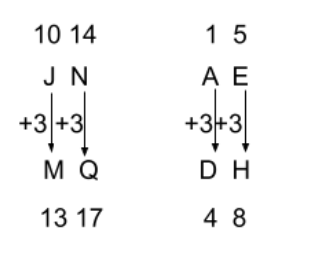
Find the missing number from the given alternatives.
8 5 6
3 7 5
1 4 2
74 90 ?
दिए गए विकल्पों में से लुप्त अंक ज्ञात कीजिये l
8 5 6
3 7 5
1 4 2
74 90 ?
The fourth number is obtained by adding the square of the first three digits of each row.
(8)^2 + (3)^2 +(1)^2 = 64+9+1 = 74
(5)^2 + (7)^2 + (4)^2 = 25 + 49 + 16 = 90
(6)^2 + (5)^2 + (2)^2 = 36 + 25 + 4 = 65
Hence the missing number is 65.
So the correct answer is option A.
प्रत्येक पंक्ति के प्रथम तीन अंको का वर्ग करके जोड़ने पर चौथी संख्या प्राप्त होगी l
(8)^2 + (3)^2 +(1)^2 = 64+9+1 = 74
(5)^2 + (7)^2 + (4)^2 = 25 + 49 + 16 = 90
(6)^2 + (5)^2 + (2)^2 = 36 + 25 + 4 = 65
अतः लुप्त संख्या 65 है l
इसलिए सही उत्तर विकल्प A है l
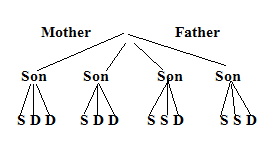
The Torpic of cancer passes through how many states of India?
कर्क रेखा भारत के कितने राज्यों से होकर गुजरती है ?
The Tropic of Cancer passes through eight states of India. These eight states are -
Tropic of Cancer is 23°30' north latitude line located in the Northern Hemisphere.
This line passes through the middle of India.
The Tropic of Cancer divides India into two parts, North India and South India.
The Tropic of Cancer also passes through Bangladesh between West Bengal and Tripura.
The Mahi River is the only river in India that crosses the tropic of Cancer twice.
The Mahi River crosses the Tropic of Cancer once in Madhya Pradesh and once in Gujarat.
The total length of the Mahi River is about 576 km.
The Tropic of Cancer passes through 17 countries of the 3 continents of the world.
The Tropic of Cancer passes through 6 water bodies of the world.
Click here to read the full article about tropic of cancer in India.
Hence the correct answer is option C.
कर्क रेखा भारत के आठ राज्यों से होकर गुजरती है। ये आठ राज्य हैं -
कर्क रेखा 23°30' उत्तरी अक्षांश रेखा है जो उत्तरी गोलार्ध में स्थित है।
यह रेखा भारत के मध्य से होकर गुजरती है।
कर्क रेखा भारत को दो भागों उत्तर भारत और दक्षिण भारत में बांटती है।
कर्क रेखा पश्चिम बंगाल और त्रिपुरा के बीच बांग्लादेश से होकर गुजरती है।
माही नदी भारत की एकमात्र ऐसी नदी है जो कर्क रेखा को दो बार काटती है।
माही नदी एक बार मध्य प्रदेश में और एक बार गुजरात में कर्क रेखा को पार करती है।
माही नदी की कुल लंबाई लगभग 576 किमी है।
कर्क रेखा विश्व के 3 महाद्वीपों के 17 देशों से होकर गुजरती है।
कर्क रेखा विश्व की 6 जलराशियों से होकर गुजरती है।
भारत में कर्क रेखा, के बारे में विस्तार से पढने के लिए यहाँ click करे l
अतः सही उत्तर विकल्प C है।
Convection is a process in which hot, less dense materials rise upward and are replaced by colder, more dense materials.
Convection is a transfer method or transmission of heat by the overall transfer of molecules in a fluid (gas, liquid, or plasma). Convection is not possible in solids, but convection is one of the main methods of heat transfer in liquids.
So the correct answer is option D.
संवहन एक ऐसी प्रक्रिया है जिसमें गर्म, कम सघन पदार्थ ऊपर की ओर उठते हैं और उन्हें ठंडे, अधिक सघन पदार्थों द्वारा प्रतिस्थापित किया जाता है।
संवहन एक तरल पदार्थ (गैस, तरल, या प्लाज्मा) में अणुओं के समग्र हस्तांतरण द्वारा एक हस्तांतरण विधि या ताप का संचरण है। ठोस में संवहन संभव नहीं है, लेकिन संवहन तरल पदार्थों में ताप हस्तांतरण के मुख्य तरीकों में से एक है।
इसलिए सही उत्तर विकल्प D है l
With reference to the religious practices in India, the “Sthanakvasi” sect belongs to
भारत में धार्मिक प्रथाओं के संदर्भ में, "स्थानकवासी" संप्रदाय का संबंध है
The Sthanakavasi are a sub-sect of the Shwetambar Jain sect. It was founded around 1653 AD by a merchant named Lavji. This sect believes that God is formless, so he does not worship any idol. The sect is essentially a reformation of the one founded on the teachings of the fifteenth-century Jain reformer Lokashah. Thirty-two of the Sthanakavasin Jain Agamas accept the Shvetambara doctrine. The Svetambarins who are not Sthanakavasin are mostly part of the pagan sect. The Sthanakavasi originated not directly from the Shvetambars, but as reformers of an older reformist sect, such as the Lonka sect of Jainism. This Lonka sect was founded in about 1474 AD by a wealthy and educated businessman from Ahmedabad, Lokshah. The main principle of this sect was not to practice idol worship. Later, some members of the Lonka sect rejected the ways of life of their current ascetics, declaring that they lived less strictly than Mahavira's wishes. A Lonka sect layman, Viraji of Surat received initiation as a yeti, i.e. an ascetic, and received much praise because of the harshness of his life. Many people from the Lonka sect joined this reformer and took the name of Sthanakavasi, intending to strictly follow the principles of Lord Mahavira. Sthanakavasi means those who do not perform their religious activities in temples but perform their religious duties known as Sthanakas which are like prayer halls. The Sthanakwasis is also called by the terms (1) Dhudhiya (searcher) or(2) Sadhumargi
So the correct answer is option B.
स्थानकवासी श्वेतांबर जैन संप्रदाय का एक उप-संप्रदाय है। इसकी स्थापना 1653 ईस्वी के आसपास लवजी नाम के एक व्यापारी ने की थी। यह संप्रदाय मानता है कि भगवान निराकार हैं, इसलिए वह किसी मूर्ति की पूजा नहीं करते हैं।संप्रदाय अनिवार्य रूप से पंद्रहवीं शताब्दी के जैन सुधारक लोंकाशाह की शिक्षाओं पर स्थापित एक का सुधार है। स्थानकवासिन, जैन आगमों में से बत्तीस, श्वेतांबर सिद्धांत को स्वीकार करते हैं। श्वेतांबरिन जो स्थानकवासिन नहीं हैं, ज्यादातर मूर्तिपुजक संप्रदाय का हिस्सा हैं।स्थानकवासी सीधे तौर पर श्वेतांबरों से नहीं, बल्कि एक पुराने सुधारक संप्रदाय के सुधारक के रूप में उत्पन्न हुए, जैसे जैन धर्म के लोंका संप्रदाय। इस लोंका संप्रदाय की स्थापना लगभग 1474 ई. में अहमदाबाद के एक धनी और पढ़े-लिखे व्यापारी लोंकशाह ने की थी lइस संप्रदाय का मुख्य सिद्धांत मूर्ति पूजा का अभ्यास नहीं करना था। बाद में, लोंका संप्रदाय के कुछ सदस्यों ने अपने वर्तमान तपस्वियों के जीवन के तरीकों को अस्वीकार कर दिया, यह घोषणा करते हुए कि वे महावीर की इच्छा से कम सख्ती से रहते थे। एक लोन्का संप्रदाय के आम आदमी, सूरत के विराजी ने एक यति, यानी एक तपस्वी के रूप में दीक्षा प्राप्त की, और अपने जीवन की कठोरता के कारण बहुत प्रशंसा प्राप्त की। लोंका संप्रदाय के कई लोग इस सुधारक में शामिल हुए और उन्होंने स्थानकवासी का नाम लिया, जिससे भगवान महावीर के सिद्धांतों का सख्ती से पालन करने का इरादा था। स्थानकवासी का अर्थ है जो मंदिरों में अपनी धार्मिक गतिविधियों को नहीं करते हैं, लेकिन अपने धार्मिक कर्तव्यों का पालन करते हैं जिन्हें स्थानक कहा जाता है जो प्रार्थना हॉल की तरह होते हैं।स्थानकवासियों को इस प्रकार भी कहा जाता है -(1) धुंधिया (खोजकर्ता) या(2) साधुमार्गी (साधुओं के अनुयायी यानी तपस्वी)
इसलिए सही उत्तर विकल्प B है।
Who determines the sex of the child?
बच्चे का लिंग कौन निर्धारित करता है?
Hence the correct answer is option D.
अतः सही उत्तर विकल्प D है l
कंप्यूटर द्वारा प्रिंटेड आउटपुट को कहा जाता है?
The printed output from a computer is called Hard Copy. Sometimes referred to as a printout, a hard copy is so-called because it exists as a physical object.
The same information, viewed on a computer display or sent as an e-mail attachment, is sometimes referred to as a soft copy.
So the correct answer is option A.
कंप्यूटर से प्रिंटेड आउटपुट को हार्ड कॉपी कहा जाता है। कभी-कभी इसे प्रिंटआउट भी कहा जाता है, इसे हार्ड कॉपी इसलिए कहा जाता है क्योंकि यह एक भौतिक वस्तु के रूप में मौजूद होती है।
वही जानकारी, जिसे कंप्यूटर डिस्प्ले पर देखा जाता है या ई-मेल अटैचमेंट के रूप में भेजा जाता है, को सॉफ्ट कॉपी कहा जाता है।
इसलिए सही उत्तर विकल्प A है।
Which amendment amended the Preamble and changed the description of India from 'Sovereign Democratic Republic' to Sovereign Socialist, Secular, Democratic Republic?
किस संशोधन द्वारा प्रस्तावना में सशोधन किया और भारत के विवरण को 'सार्वभौम लोकतांत्रिक गणराज्य' से सार्वभौम समाजवादी, धर्मनिरपेक्ष, लोकतांत्रिक गणराज्य में बदल दिया?
The 42nd Amendment amended the Preamble and changed the description of India from "sovereign democratic republic" to "sovereign, socialist secular democratic republic", and also changed the words "unity of the nation" to "unity and integrity of the nation".The 42nd Amendment, officially known as the Constitution (Forty-second Amendment) Act, 1976, was enacted by the Indian National Congress government led by Indira Gandhi during the Emergency (25 June 1975 – 21 March 1977). This amendment is considered to be the most controversial amendment in Indian history. The 42nd amendment was brought by Indira Gandhi during the Emergency to fulfill personal ambitions. The 42nd Constitutional Amendment is also called 'Mini-Constitution' or 'Constitution of Indira'.Most of the provisions of the amendment came into force on 3 January 1977, others came into force on 1 February. By this constitutional amendment, an attempt was made to reduce the power of the Supreme Court and the High Courts.
So the correct answer is option D.
42वें संशोधन ने प्रस्तावना में संशोधन किया और भारत के विवरण को "संप्रभु लोकतांत्रिक गणराज्य" से "संप्रभु, समाजवादी धर्मनिरपेक्ष लोकतांत्रिक गणराज्य" में बदल दिया, और "राष्ट्र की एकता" शब्दों को "राष्ट्र की एकता और अखंडता" में भी बदल दिया।42वां संशोधन, जिसे आधिकारिक तौर पर संविधान (बयालीसवां संशोधन) अधिनियम, 1976 के रूप में जाना जाता है, आपातकाल (25 जून 1975 - 21 मार्च 1977) के दौरान इंदिरा गांधी के नेतृत्व वाली भारतीय राष्ट्रीय कांग्रेस सरकार द्वारा अधिनियमित किया गया था।इस संशोधन को भारतीय इतिहास का सबसे विवादास्पद संशोधन माना जाता है।42वां संशोधन इंदिरा गांधी द्वारा आपातकाल के दौरान व्यक्तिगत महत्वाकांक्षाओं को पूरा करने के लिए लाया गया था।42वें संविधान संशोधन को 'मिनी-संविधान' या 'इंदिरा का संविधान' भी कहा जाता है।संशोधन के अधिकांश प्रावधान 3 जनवरी 1977 को लागू हुए, अन्य 1 फरवरी से लागू हुए।इस संवैधानिक संशोधन द्वारा सर्वोच्च न्यायालय और उच्च न्यायालयों की शक्ति को कम करने का प्रयास किया गया।
इसलिए सही उत्तर विकल्प D है।
Three taps A, B and C can fill a tank in 12,15 and 20 hours respectively. If A is open all the time and B ,C are open for one hour each alternatively, the tank will be full in:
तीन नल A, B और C एक टंकी को क्रमशः 12,15 और 20 घंटे में भर सकते हैं। यदि A हर समय खुला रहता है और B,C बारी-बारी से एक-एक घंटे के लिए खुले रहते हैं, तो टंकी कितने समय में भर जाएगी?
Tap A can fill the tank in 12 hours.
Tap B can fill the tank in 15 hours.
Tap C can fill the tank in 20 hours.
If A is open all the time and B ,C are open for one hour each alternatively.
The part of the tank filled by tap A and B in 1 hours = 1/12+1/15 = 5+4/60 = 9/60 = 3/20
The part of the tank filled by tap A and C in 1 hours = 1/12+1/20 = 5+3/60 = 8/60 = 2/15
The part of the tank filled by tap A, B and C in 2 hours = 3/20+2/15 = 9+8/60 = 17/60
The part of the tank filled by tap A, B and C in 6 hours = 17*3/60 = 17/20
Now the remaining part = 1-17/20 = 3/20
Now its turn of A and B.
The part of the tank filled by tap A and B in 1 hours is 3/20 and the remaining part is also 3/20.
So A and B can fill the remaining part in 1 hours.
Now the total time taken to fill the tank = 6 hours + 1 hours = 7 hours
Hence the correct answer is option A.
नल A टंकी को 12 घंटे में भर सकता है।
नल B टंकी को 15 घंटे में भर सकता है।
नल C टंकी को 20 घंटे में भर सकता है।
यदि A हर समय खुला रहता है और B,C बारी-बारी से एक-एक घंटे के लिए खुले रहते हैं।
नल A और B द्वारा 1 घंटे में भरा गया टैंक का हिस्सा = 1/12+1/15 = 5+4/60 = 9/60 = 3/20
नल A और C द्वारा 1 घंटे में भरा गया टैंक का हिस्सा = 1/12+1/20 = 5+3/60 = 8/60 = 2/15
नल A, B और C द्वारा 2 घंटे में भरा गया टैंक का हिस्सा = 3/20+2/15 = 9+8/60 = 17/60
नल A, B और C द्वारा 6 घंटे में भरा गया टैंक का हिस्सा = 17*3/60 = 17/20
अब शेष भाग = 1-17/20 = 3/20
अब A और B की बारी है।
नल A और B द्वारा 1 घंटे में भरा गया टैंक का भाग 3/20 है और शेष भाग भी 3/20 है।
अतः A और B शेष भाग को 1 घंटे में भर सकते हैं।
टंकी को भरने में लगा कुल समय = 6 घंटे + 1 घंटा = 7 घंटे
अतः सही उत्तर विकल्प A है।
A tank is filled in eight hours by three pipes K, L and M. Pipe K is twice as fast as pipe L, and L is twice as fast as M. How much time will pipe L alone take to fill the tank?
तीन पाइप K, L और M द्वारा एक टैंक को आठ घंटे में भरा जाता है। पाइप K, पाइप L से दोगुना तेज है, और L, M से दोगुना तेज है। पाइप L अकेले टैंक को भरने में कितना समय लेगा?
A tank is filled in eight hours by three pipes K, L and M.
The part filled by all three pipes K, L and M in 1 hours = ⅛
Pipe K is twice as fast as pipe L, and L is twice as fast as M.
Let pipe K can fill the tank in x hrs.
The part filled by pipe K in 1 hrs = 1/x
Then the pipe L can fill the tank in 2x hrs and pipe M can fill the tank in 4x hrs.
The part filled by pipe L in 1 hrs = 1/2x
The part filled by pipe M in 1 hrs = 1/4x
According to the question -
1/x+1/2x+1/4x=⅛
4+2+1/4x=⅛
7/4x=⅛
x = 14
Pipe L can fill the tank in 2x hrs = 2*14=28 hrs.
Hence the correct answer is option C.
एक टैंक तीन पाइप K, L और M द्वारा आठ घंटे में भरा जाता है।
तीनों पाइप K, L और M द्वारा 1 घंटे में भरा गया भाग = ⅛
पाइप K, पाइप L से दोगुना तेज़ है, और L, M से दोगुना तेज़ है।
माना पाइप K टंकी को x घंटे में भर सकता है।
पाइप K द्वारा 1 घंटे में भरा गया भाग = 1/x
पाइप L टैंक को 2x घंटे में भर सकता है और पाइप M टैंक को 4x घंटे में भर सकता है।
पाइप L द्वारा 1 घंटे में भरा गया भाग = 1/2x
पाइप M द्वारा 1 घंटे में भरा गया भाग = 1/4x
प्रश्न के अनुसार -
1/x+1/2x+1/4x=⅛
4+2+1/4x=⅛
7/4x=⅛
x = 14
पाइप L टैंक को 2x घंटे = 2*14= 28 घंटे में भर सकता है।
अतः सही उत्तर विकल्प C है।